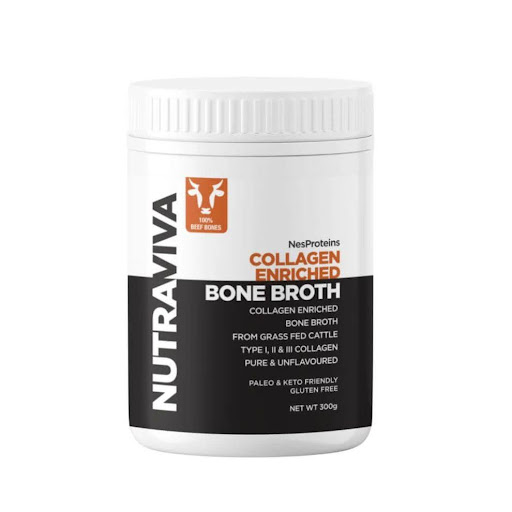Bone broth has made a massive comeback in the health and wellness world – and for good reason. This golden, nutrient-dense liquid has been a part of traditional diets for centuries. Whether you’re sipping it for warmth, using it in soups, or as part of a fitness plan, bone broth provides healing power that modern science now recognizes.
In this article, we’ll explore what bone broth is, its nutritional value, health benefits, and how you can easily make it at home.
What is Bone Broth?
Bone broth is a protein-rich liquid made by simmering animal bones, connective tissues, and vegetables for long hours – often between 12 to 48 hours. This slow-cooking process draws out valuable nutrients like collagen, amino acids, and minerals, turning ordinary bones into a powerful natural supplement.
You can make bone broth from:
- Beef bones for deep flavor and high collagen
- Chicken bones for a lighter, soothing broth
- Fish bones for a mineral-rich and delicate broth
People often add herbs, garlic, ginger, onions, and apple cider vinegar for flavor and extra nutrition.
How to Make Bone Broth at Home
Making bone broth at home is simple, affordable, and more nutritious than store-bought versions.
Ingredients:
- 1–2 kg of beef, chicken, or fish bones
- 2 tablespoons apple cider vinegar (helps extract nutrients)
- 1 onion, 2 carrots, 2 celery stalks
- 3–4 garlic cloves (optional)
- 1 tsp salt and pepper
- Enough water to cover the bones
Instructions:
- Roast the bones (optional) at 200°C for 30 minutes – it adds rich flavor.
- Place bones and vegetables in a large pot or slow cooker.
- Add apple cider vinegar and cover with water.
- Simmer on low heat for 12–24 hours (or longer for maximum nutrients).
- Strain and store in glass jars.
You can drink it warm like soup or use it as a base for sauces, gravies, or curries.
Nutritional Profile of Bone Broth
Bone broth is packed with essential nutrients that the body easily absorbs:
| Nutrient | Benefit |
| Collagen | Improves skin elasticity and joint health |
| Gelatin | Supports digestion and gut healing |
| Amino acids (Glycine, Proline, Glutamine) | Aid in tissue repair and muscle growth |
| Minerals (Calcium, Magnesium, Phosphorus) | Strengthen bones and teeth |
| Electrolytes | Keep you hydrated and energized |
Despite being low in calories, bone broth provides a high level of nourishment for your body.
Top 7 Health Benefits of Bone Broth
1. Improves Joint Health
Bone broth is rich in collagen and gelatin, which help rebuild cartilage and reduce joint pain. It’s particularly helpful for people suffering from arthritis or joint stiffness.
2. Boosts Gut Health
The gelatin in bone broth repairs the gut lining and supports healthy digestion. It’s especially beneficial for people dealing with leaky gut syndrome or frequent bloating.
3. Promotes Glowing Skin, Hair, and Nails
Collagen is a key protein for skin elasticity and hydration. Regular consumption of bone broth helps reduce wrinkles, strengthens nails, and makes your hair shinier.
4. Strengthens the Immune System
Bone broth contains minerals like zinc and magnesium that support immune defense. It’s a natural way to fight off seasonal flu, colds, and fatigue.
5. Aids Weight Loss
Low in calories but high in protein, bone broth keeps you full longer and helps reduce hunger cravings – a perfect addition to a healthy weight-loss diet.
6. Enhances Sleep and Mood
The amino acid glycine found in bone broth has a calming effect on the brain, improving sleep quality and reducing stress levels.
7. Supports Muscle Recovery
For athletes and fitness lovers, bone broth helps in muscle repair and recovery due to its high amino acid content.
How to Include Bone Broth in Your Daily Diet
You can enjoy bone broth in many simple and delicious ways:
- Sip a warm cup in the morning instead of tea or coffee
- Use it as a base for soups, gravies, and stews
- Cook rice or pasta in bone broth for extra flavor
- Add to mashed potatoes for a creamy texture
- Mix with herbs and spices as a post-workout drink
Who Should Avoid Bone Broth?
While bone broth is generally safe, people with histamine intolerance, kidney problems, or food allergies should consult a doctor before regular use. Always choose grass-fed, organic bones to avoid toxins and chemicals.
Tips for Best Results
- Use bones with marrow and joints – they’re rich in collagen.
- Add apple cider vinegar for better mineral extraction.
- Simmer slowly – don’t boil!
- Store in the fridge for up to 5 days or freeze for 3 months.
Final Thoughts
Bone broth isn’t just a passing health trend – it’s an ancient, time-tested food that nourishes your body from within. Whether you want healthier skin, stronger joints, or better digestion, this warm golden liquid delivers natural healing benefits in every sip.


